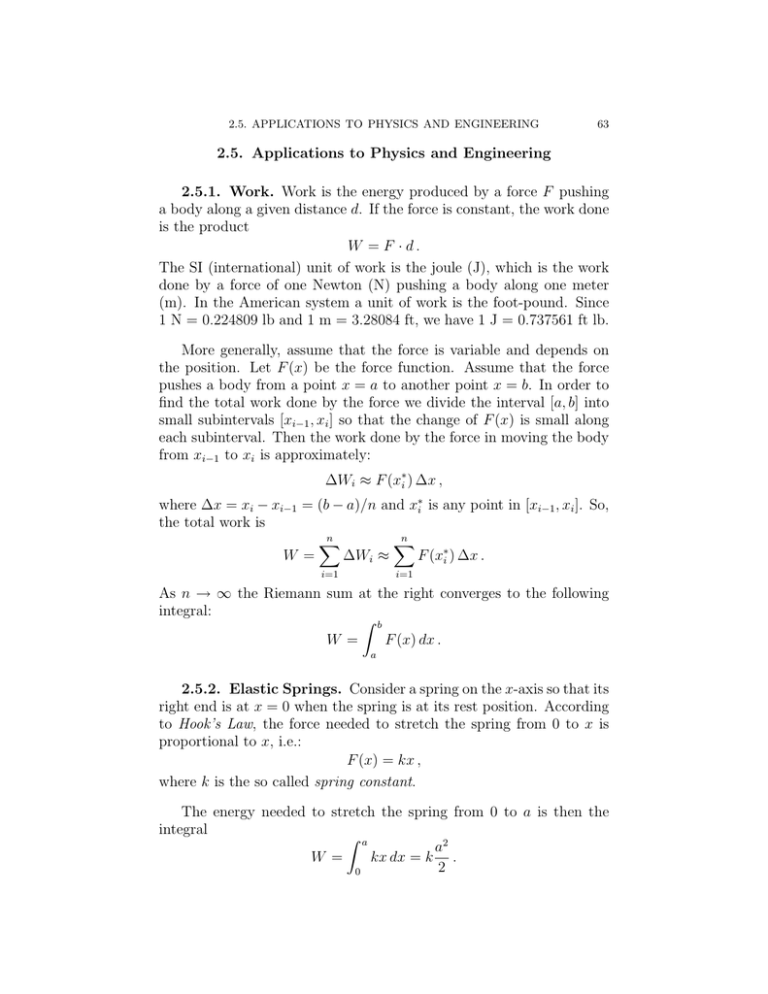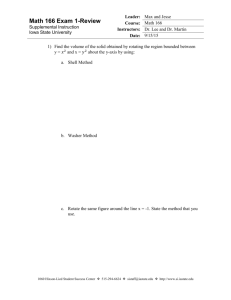2.5. Applications to Physics and Engineering 2.5.1. Work. Work is
advertisement

2.5. APPLICATIONS TO PHYSICS AND ENGINEERING 63 2.5. Applications to Physics and Engineering 2.5.1. Work. Work is the energy produced by a force F pushing a body along a given distance d. If the force is constant, the work done is the product W = F · d. The SI (international) unit of work is the joule (J), which is the work done by a force of one Newton (N) pushing a body along one meter (m). In the American system a unit of work is the foot-pound. Since 1 N = 0.224809 lb and 1 m = 3.28084 ft, we have 1 J = 0.737561 ft lb. More generally, assume that the force is variable and depends on the position. Let F (x) be the force function. Assume that the force pushes a body from a point x = a to another point x = b. In order to find the total work done by the force we divide the interval [a, b] into small subintervals [xi−1 , xi ] so that the change of F (x) is small along each subinterval. Then the work done by the force in moving the body from xi−1 to xi is approximately: ∆Wi ≈ F (x∗i ) ∆x , where ∆x = xi − xi−1 = (b − a)/n and x∗i is any point in [xi−1 , xi ]. So, the total work is n n X X W = ∆Wi ≈ F (x∗i ) ∆x . i=1 i=1 As n → ∞ the Riemann sum at the right converges to the following integral: Z b W = F (x) dx . a 2.5.2. Elastic Springs. Consider a spring on the x-axis so that its right end is at x = 0 when the spring is at its rest position. According to Hook’s Law, the force needed to stretch the spring from 0 to x is proportional to x, i.e.: F (x) = kx , where k is the so called spring constant. The energy needed to stretch the spring from 0 to a is then the integral Z a a2 W = kx dx = k . 2 0 2.5. APPLICATIONS TO PHYSICS AND ENGINEERING 64 2.5.3. Work Done Against Gravity. According to Newton’s Law, the force of gravity at a distance r from the center of the Earth is k F (r) = 2 , r where k is some positive constant. The energy needed to lift a body from a point at distance R1 from the center of the Earth to another point at distance R2 is given by the following integral ¸R ¶ · µ Z R2 k k 2 1 1 . W = dr = − =k − 2 r R1 R1 R2 R1 r Example: Find the energy needed to lift 1000 Km a body whose weight is 1 N at the surface of Earth. The Earth radius is 6378 Km. Answer : First we must determine the value of the constant k in this case. Since the weight of the body for r = 6378 Km is 1 N we have k/63782 = 1, so k = 63782 . Next we have R1 = 6378, R2 = 6378 + 1000 = 7378, hence µ ¶ 1 1 2 W = 6378 − = 864.462 N Km . 6378 7378 Since 1 Km = 1000 m, the final result in joule is 864.462 N Km = 864.462 N × 1000 m = 864462 J . 2.5.4. Work Done Filling a Tank. Consider a tank whose bottom is at some height y = a and its top is at y = b. Assume that the area of its cross section is A(y). We fill the tank by lifting from the ground (y = 0) tiny layers of thickness dy each. Their mass is ρA(y) dy, where ρ is the density (mass per unit of volume) of the liquid that we are putting in the tank. We get their weight dF by multiplying by the acceleration of gravity g (= 9.8 m/s2 = 32 ft/s2 ), so dF = ρgA(y) dy. The work needed to lift each layer is dW = dF · y = ρgyA(y) dy . Hence, the work needed to fill the tank is Z b W = ρgyA(y) dy . a 2.5. APPLICATIONS TO PHYSICS AND ENGINEERING 65 2.5.5. Emptying a Tank. Consider a tank like the one in the previous paragraph. Now we empty it by pumping its liquid to a fix height h. The analysis of the problem is similar to the previous paragraph, but now the work done to pump a tiny layer of thickness dy is dW = dF · (h − y) = ρg (h − y)A(y) dy . Hence the total work needed to empty the tank is Z b ρg (h − y)A(y) dy . W = a 2.5.6. Force Exerted by a Liquid Against a Vertical Wall. The pressure p of an homogeneous liquid of density ρ at depth h is p = ρgh . When the pressure is constant, the force exerted by the liquid against a surface is the product of the pressure and the area of the surface. However the pressure against a vertical wall is not constant because it depends on the depth. Assume that the surface of the liquid is at y = c and we place a vertical plate of width w(y) between y = a and y = b. The force exerted at y (so at depth h = c − y) against a small horizontal strip of height dy and width w(y) (area = w(y) dy) is dF = ρg (c − y)w(y) dy . hence the total force is Z F = a b ρg (c − y)w(y) dy . Example: A cylindrical tank of radius 1 m and full of water (ρ = 1000 Kg/m3 , g = 9.8m/s2 ) is lying on its side. What is the pressure exerted by the water on its (vertical) bottom? Answer : We assume the center of the tank is at y = 0, so the top of the liquid is at y = 1, and its bottom p is at y = −1. On the other hand we obtain geometrically w(y) = 2 1 − y 2 . Hence the total force is: Z 1 p π F = 1000 · 9.8 · (1 − y)2 1 − y 2 dy = 19800 · = 30787.6 N . 2 −1





